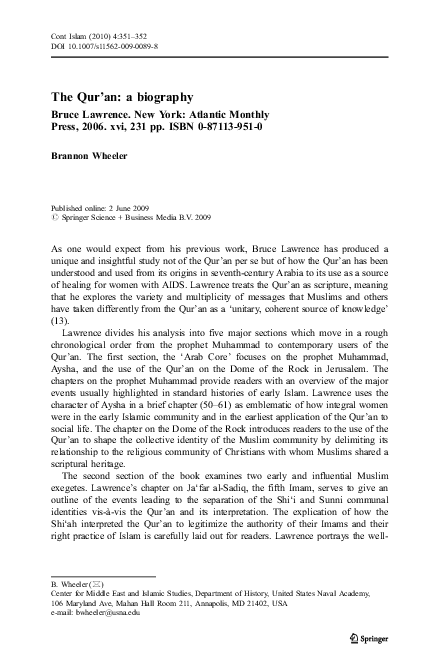Academia.edu no longer supports Internet Explorer.
To browse Academia.edu and the wider internet faster and more securely, please take a few seconds to upgrade your browser.
The Qur’an: a biography
Related Papers
The use of sacred script for polemic purposes is a method as ancient as the script itself. Biblical citations, which are used as a vehicle to support an ideology at stake, can be traced easily in various texts throughout history. Like Judaism and Christianity, Islam, from its earliest days, has integrated Qurʾānic verses into its writings, gradually turning the technique into a major form of expression. In the last few years, however, we have witnessed a significant increase in the number of Qurʾānic verses that are used as a source for the justification or sanction of specific current events. We often encounter citations of the divine word that are not limited to sacred texts or religious items, but are rather interwoven into the rhetoric of central figures and communicated through the general media. The present chapter is necessarily a preliminary study of this emerging and changing phenomenon. Islam regards the Qurʾān as the word of God that was gradually revealed to Muḥammad to answer the needs and changing circumstances of the developing nascent community. Although prophecy ended with Muḥammad's death, the idea of a perfect compatibility between the revelation and current events did not stop in the first/seventh century. Instead it expanded to the next generations and became a central part of the Qurʾānic sciences (ʿulūm al-Qurʾān), known as the " occasions of revelation " (asbāb al-nuzūl). This flexibility was facilitated by the general, sometimes vague, nature of the Qurʾānic text. Most Qurʾānic verses are phrased in a style that avoids specific details, and consequently can be understood to have more than one meaning within more than one context. Islamic scholars, therefore, could use these verses as recourse for instruction, whenever and wherever needed, thus taking these verses beyond the scope of the time in which they were revealed. This special Qurʾānic style underlies a major part of the Islamic dogma that deals with the miraculous nature of the Qurʾān (iʿjāz). The latter views the Qurʾān as a divine revelation that cannot be imitated by mortals, as an eternal and universal truth that can be adapted to changing circumstances, and as assistance and guidance that may be applied to any situation at any given time or place. The act of identifying a part of the Qurʾānic truth with a specific experience has always been accepted as an ultimate authorization. In other words, the ability to interpret a verse in a way that was relevant to a debatable issue always reinforced the confidence in the decisions taken.
Journal of Qur'anic Studies
Review of Muslim Qur'anic Interpretation Today: Media, Genealogies and Interpretive Communities, by Johanna Pink2021 •
“Re-interpreting the Qurʾān in the 21st century”, special issue edited by R.T., Religions, 12(8) (2021), https://www.mdpi.com/journal/religions/special_issues/21quran with introduction by R.T. (https://www.mdpi.com/2077-1444/13/2/134/htm, 5 p.).
Introduction to special issue on Qur'an in the journal ReligionsThis article is an open access article distributed under the terms and conditions of the Creative Commons Attribution
2018 •
For Muslims, the Qur’an is the word of God, preserved on a well-guarded tablet and revealed, through the angel Gabriel (Jibril), to the Prophet Muhammad in 611 CE. The miraculous event first occurred when Muhammad, aged 40, was meditating in a cave on Mount Hira’, three miles from Mecca, on the night of al-Qadr (the Night of Power), which is 23 Ramadan. The revelation was intermittent and lasted between twenty and twenty-five years. This revelation later became the Islamic Scripture i.e. the Quran. This holy Quran is the bedrock of Islamic faith and philosophy and praxis. This seminar explicitly deals with The Holy Qur’an.
Bulletin of the School of Oriental and African Studies
ABDULLAH SAEED: Interpreting the Qur'ān: Towards a Contemporary Approach. 192 pp. London and New York: Routledge, 2006. £16.99. 0415 36538 42007 •
RELATED PAPERS
The role of Nitrogen in breathing
A Nitrogén szerepe a légzésnél2023 •
MUSEUM OF CYCLADIC ART
ΑΡΧΑΙΟΛΟΓΙΚΕΣ ΣΥΜΒΟΛΕΣ, ΑΤΤΙΚΗ ΤΟΜΟΣ Α: ΚΣΤ & Β ΕΠΚΑ2013 •
World journal of clinical cases
Left ventricular pseudoaneurysm formation: Two cases and review of the literature2014 •
JMIR Formative Research
Adapting an Evidence-Based e-Learning Cognitive Behavioral Therapy Program Into a Mobile App for People Experiencing Gambling-Related Problems: Formative Study2021 •
Journal of business, economics and finance
The triple helix: oil prices, trade terms and unemployment: a developmental analysis of Turkiye2023 •
2019 •
Preventive Nutrition and Food Science
Food Group Intake of Pregnant Jordanian Women Based on the Three Pregnancy Trimesters2020 •
2016 •
2018 •
Miradas cruzadas en el niño
4. Representaciones y significados de la salud infantil en el PerúJournal of proteome research
Most highly expressed protein-coding genes have a single dominant isoformRELATED TOPICS
- Find new research papers in:
- Physics
- Chemistry
- Biology
- Health Sciences
- Ecology
- Earth Sciences
- Cognitive Science
- Mathematics
- Computer Science

 Brannon Wheeler
Brannon Wheeler